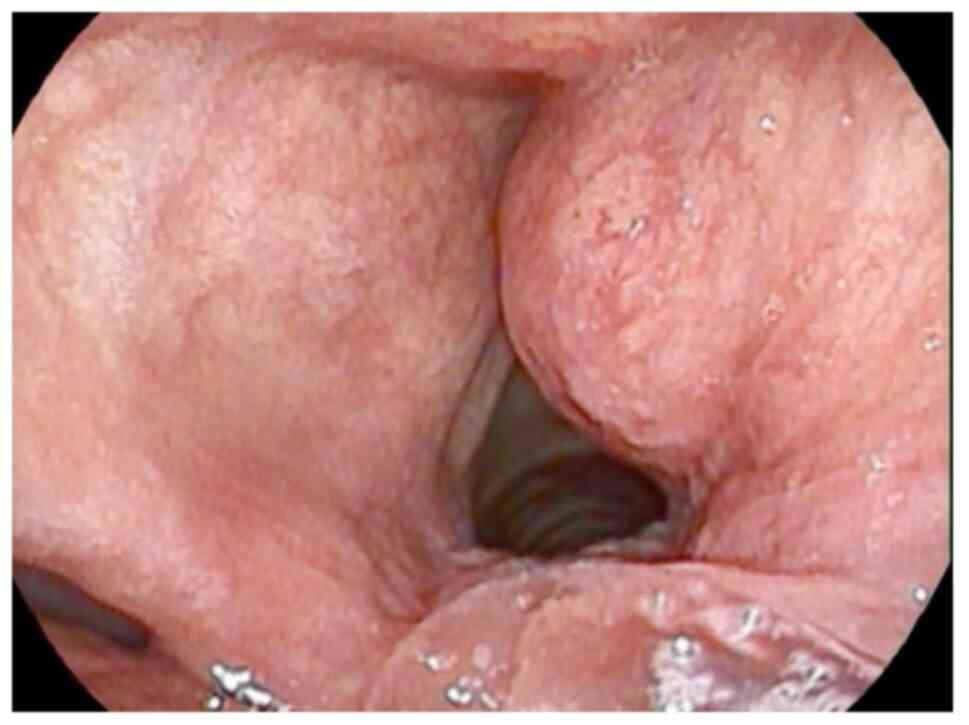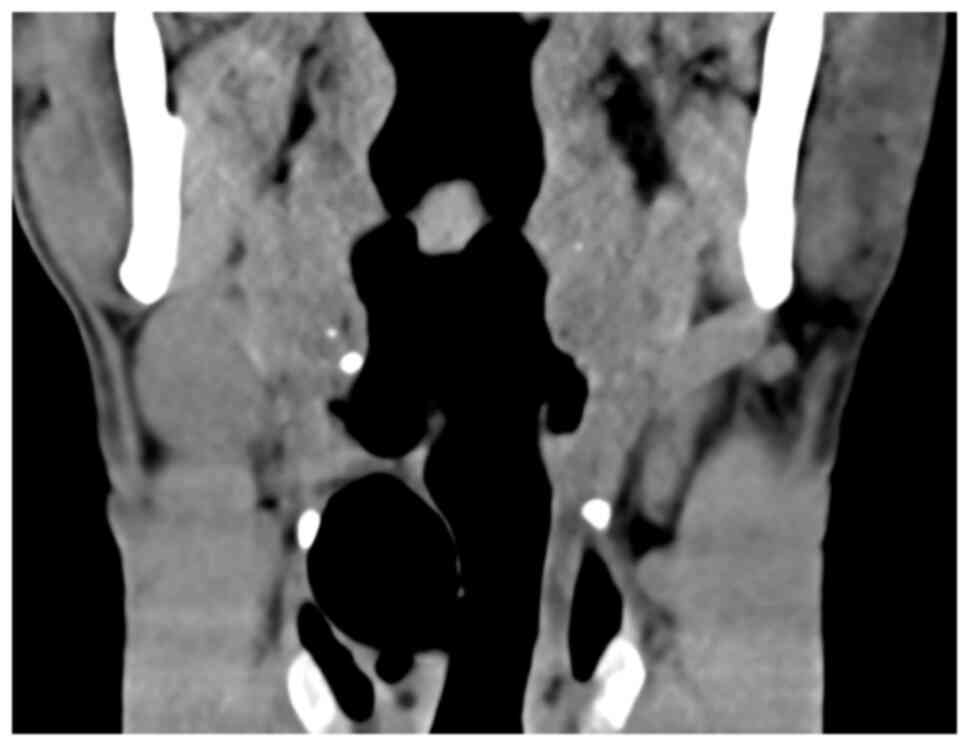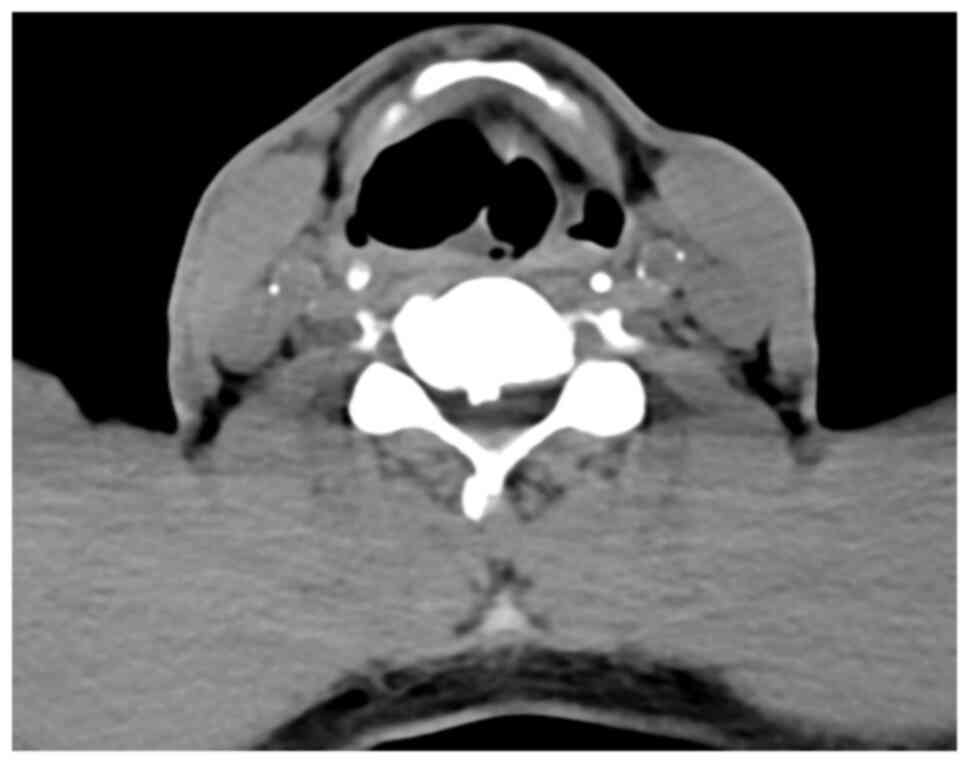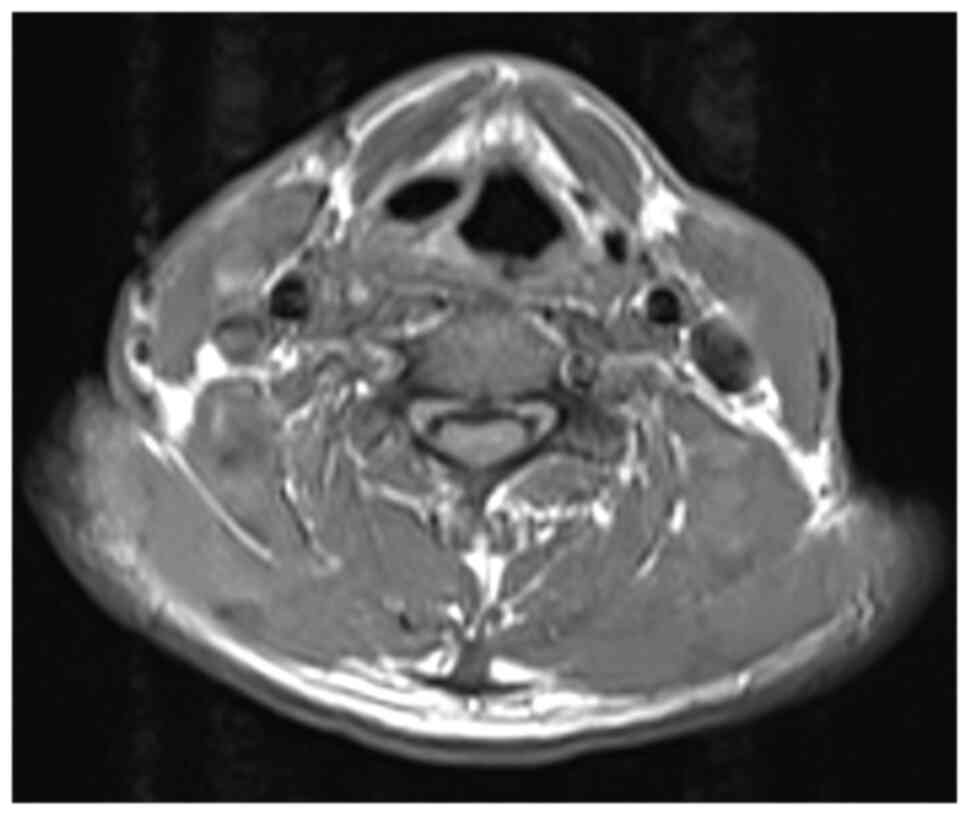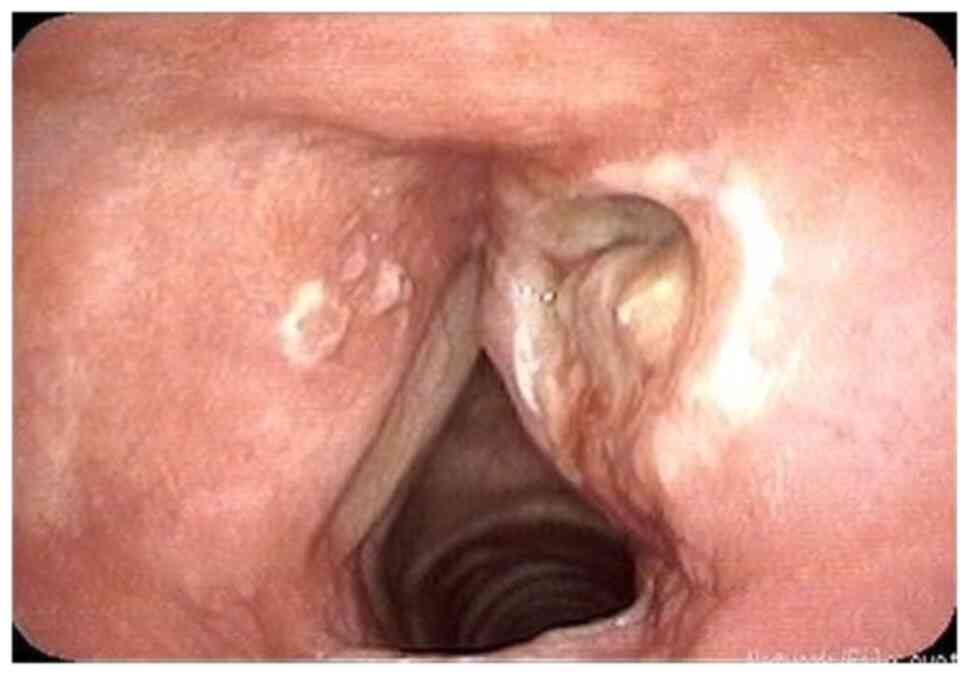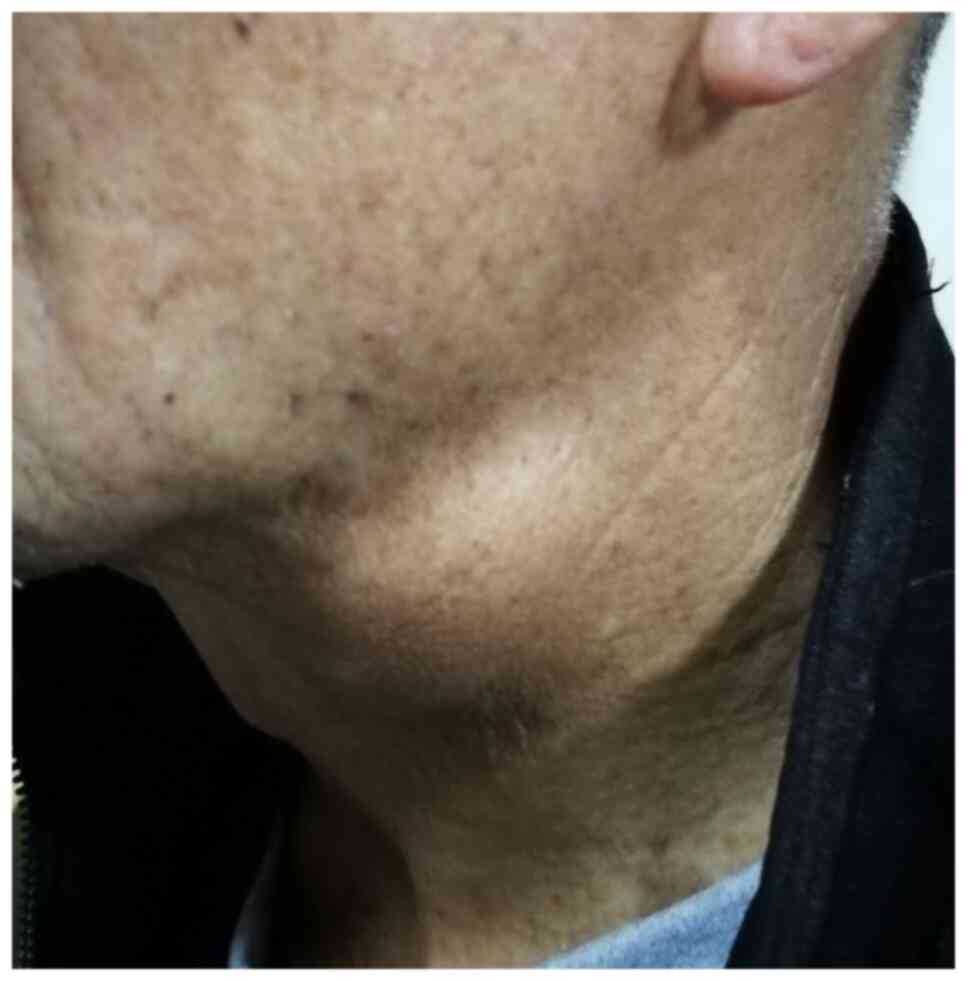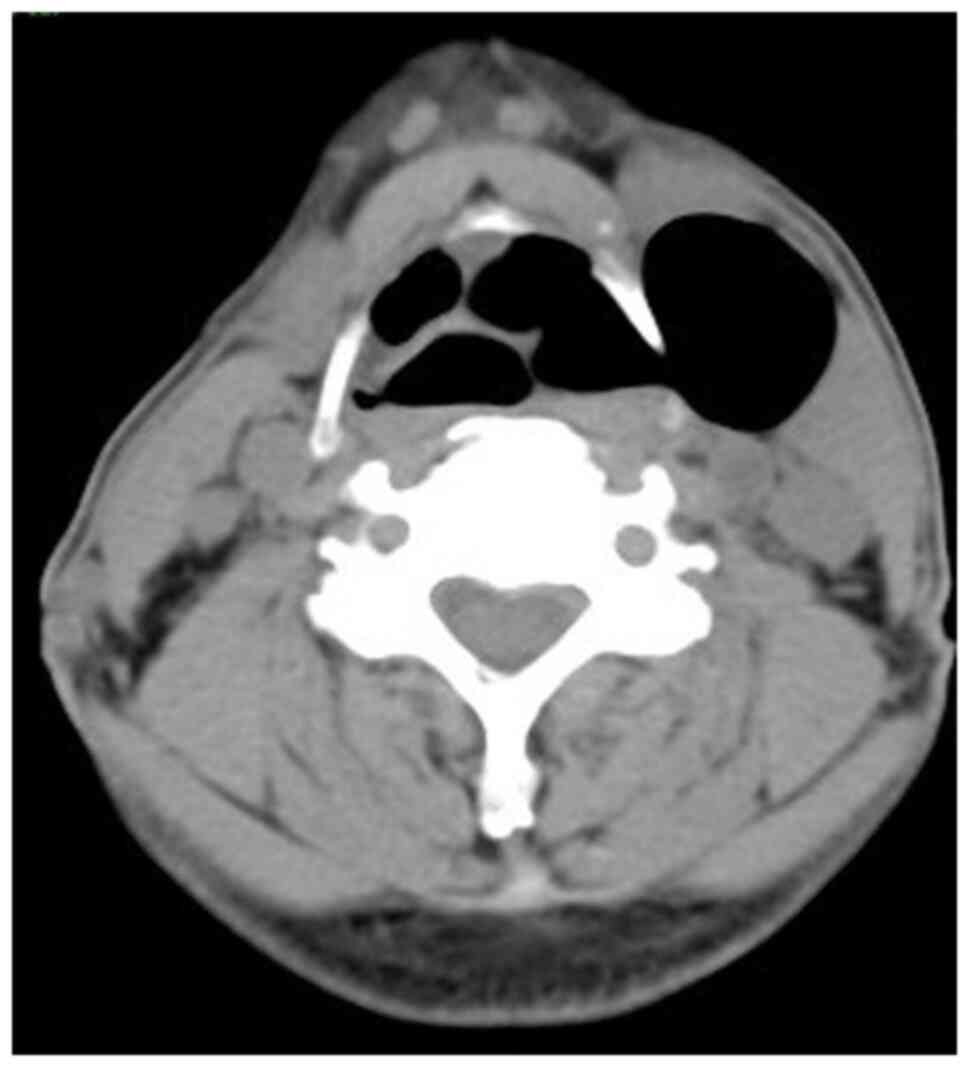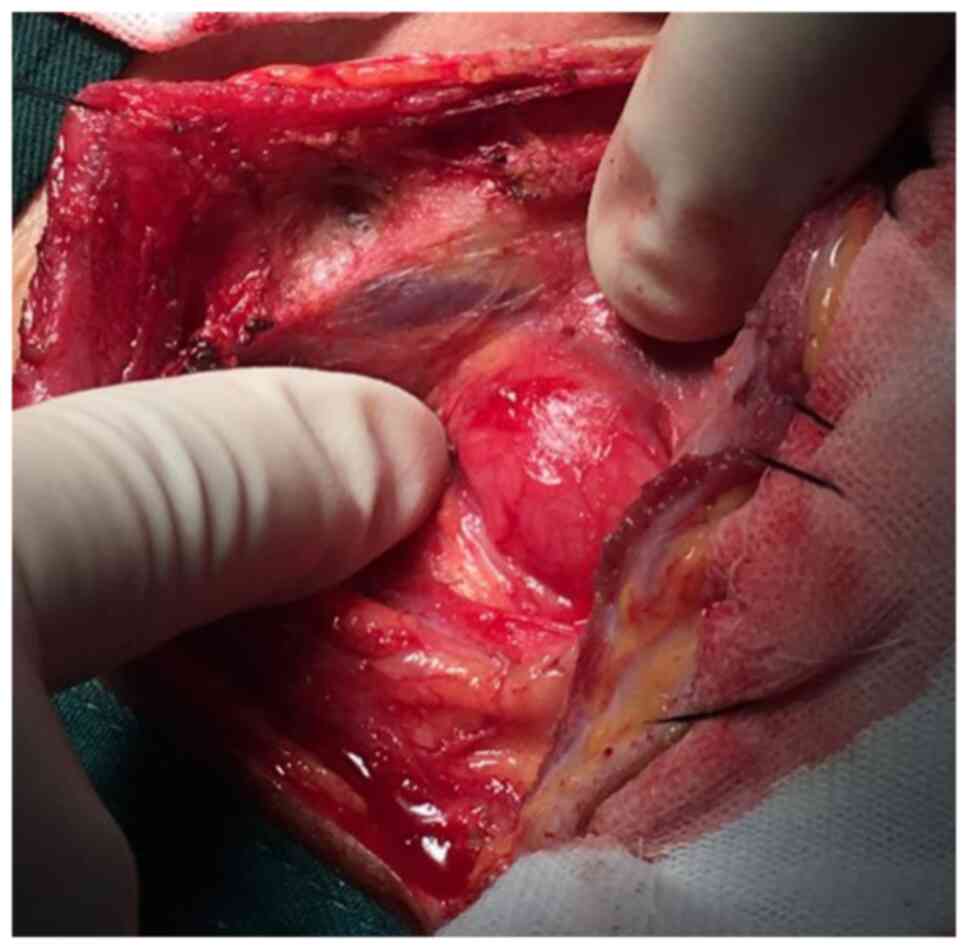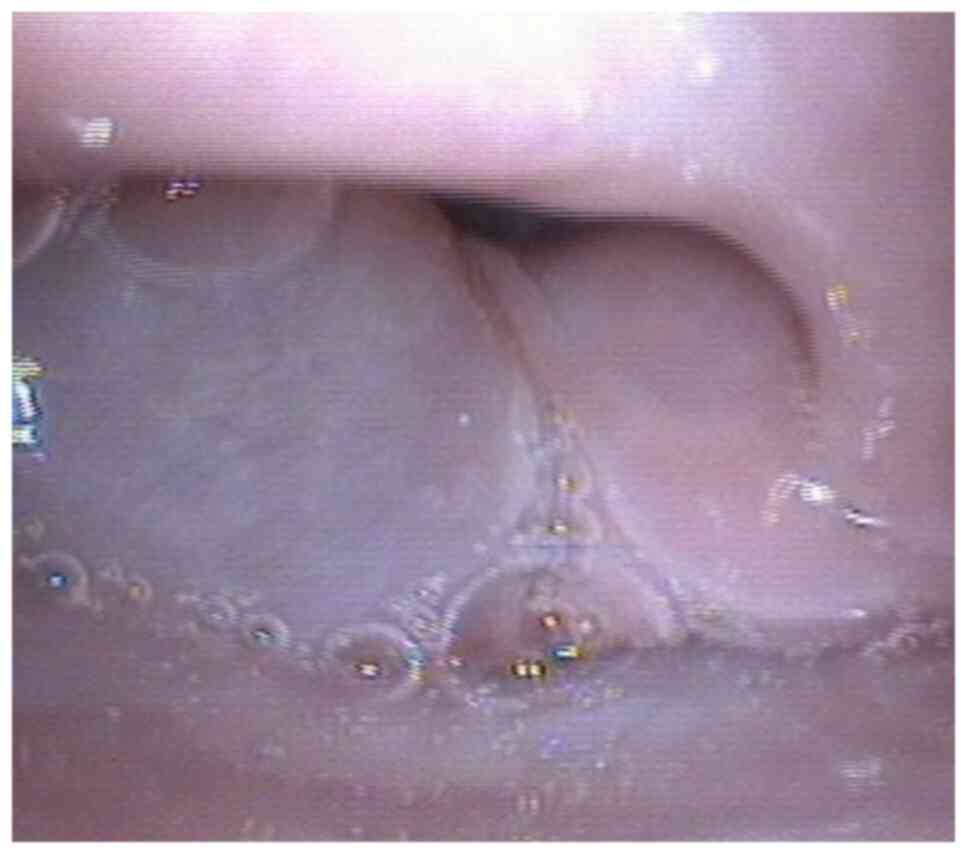Laryngocele: Report of two rare cases and review of the literature
- Authors:
- Published online on: July 17, 2023 https://doi.org/10.3892/etm.2023.12123
- Article Number: 424
-
Copyright: © Zhang et al. This is an open access article distributed under the terms of Creative Commons Attribution License.
Abstract
Introduction
A laryngocele is a rare benign dilatation of the laryngeal saccule containing air and/or fluid that interacts with the laryngeal lumen. It may be characterized as internal, exterior or mixed, depending on its location (1). This condition may be congenital or acquired and is usually unilateral (2). Laryngocele is considered an uncommon diagnosis, with a frequency of ~1 in 2.5 million individuals per year (3). According to other clinical studies (1,4), males are about five times more likely than females to suffer from laryngocele. Scholars have reported a higher incidence of the condition throughout the fifth and sixth decades of life (5). Common clinical manifestations include hoarseness of the voice and swelling of the neck. Imaging studies are critical for making a diagnosis, determining the type, location and extent of a laryngocele, and outlining the best treatment options. Despite the fact that it is a benign condition, a laryngocele may occasionally appear as an acute airway emergency and be threatening to patients' lives (6). The definitive surgical approach and tracheostomy depend on the type of laryngopyocele, its presentation and the patient's comorbidities. Since laryngopyoceles are rarely reported, no large case series has been published to date, to the best of our knowledge (7). This article introduces the management of an internal laryngocele and mixed laryngocele along with review of literature and proposed plasma resection of laryngoceles.
Case report
Case 1
A 59-year-old male patient who had been complaining of hoarseness for almost 1 year presented at Affiliated Hospital of Jining Medical University in February 2022. The patient had been treated with ‘traditional medicine’, but his condition did not sufficiently improve. This time, laryngoscopy revealed an expanded right false vocal fold with unremarkable underlying mucosa (Fig. 1). Neck CT in the coronal plane (Fig. 2) and axial plane (Fig. 3) indicated a cystic dilatation on the right side of the larynx. MRI showed a 1.3x0.7x1.9 cm cystic dilatation on the right side of the larynx, towards the level of the 4-5 cervical vertebra. Small patchy areas surrounding the saccular dilatation were hypointense on T1-weighted imaging (T1WI) and hyperintense on T2WI (Fig. 4). After analysing the results, laryngocele was considered along with certain infectious diseases. The patient had no edema on either side of the upper neck and was diagnosed with internal laryngocele after admission. Surgical therapy was performed after all contraindications were ruled out.
The medical team used a suspension laryngoscope to evaluate the right laryngeal ventricle bulge. The first procedure was to use plasma to excise the mucosa over the cyst and the laryngeal ventricle mucosa. After the excision along the root of the mass was completed, an intraoperative clear fluid with visible bubbles flowed from the capsule, and the root was cauterized with plasma radiofrequency ablation. Once the laryngocele was totally removed, the incision was rinsed and checked for bleeding. The operation was completed successfully without any surgical harm to the vocal cords. After the procedure, it was concluded that there was also no need for a tracheostomy. On the second postoperative day, a laryngoscope revealed white pseudomembrane adherence on the trauma surface, with no obvious swelling (Fig. 5). There were no perioperative or early postoperative issues. Within 24 h, the patient was allowed to resume his oral diet. A follow-up was conducted 6 months after the procedures and the patient showed no recurrence or other relevant changes to his clinical condition.
Case 2
A 68-year-old male patient presented at the Affiliated Hospital of Jining Medical University in December 2017 with a major sign of a swelling on the left side of the upper aspect of the neck (Fig. 6) and complained of pain for >1 month. Upon coughing or using the Valsalva maneuver, the swelling grew larger. The patient reported that recently, the swelling's size had been progressively increasing and that he had been frequently experiencing breathlessness and hoarseness after activities. The results of a laryngoscopy revealed a cystic neoplasm with a smooth surface in the left ventricle zone and normal mobility of the bilateral vocal cords. The patient works as a farmer and has a positive smoking history. After collection of the case data, the patient underwent a complete CT scan, which revealed a huge air-filled lump in the left neck (Fig. 7). Furthermore, on MRI, a 4.3x3.1x4.6 cm rounded aberrant signal was visible in the left false vocal cords. The lesion had a clear boundary and a homogeneous signal, which was hypointense on T1WI and T2WI and absent on diffusion-WI and spread to the neck, leading to the diagnosis of a combination laryngocele.
Routine tests were subsequently performed and the patient was prepped for excision by an external transcervical technique under general anesthesia. An incision was made at the anterior border of the sternocleidomastoid muscle, approximately at the level between the hyoid bone and the thyroid cartilage, meticulously separated from its surroundings (Fig. 8). The tumor entered the laryngeal cavity via the left lower margin of the epiglottis, then the left laryngeal chamber and finally the median split laryngeal cavity. During the procedure, the medical team discovered that it had extended to the anterior commissure. After being peeled off to the root of the cyst, the mass was removed after ligation at the root. Rapid pathology revealed benign cystic lesions, so a tracheostomy was performed. The pathological features observed after the operation revealed a cyst lined with ciliated columnar epithelium. A laryngoscopy was conducted one week after the surgery and showed that the wound had closed without any recurrences (Fig. 9).
Discussion
Dr Larrey, a distinguished physician of Napoleon's forces in Egypt, reported laryngocele for the first time in 1829. However, the condition was officially defined by Virchow many years later, in 1867(8). Most specialists divide laryngocele into three types (9): i) Internal, which is restricted to the thyrohyoid membrane and presents as a mass in the false vocal cord; ii) external, which extends into the neck subcutaneous tissue; and iii) a combination of both. Al-Yahya et al (7) analysed 61 papers published between 1952 and 2015, concluding that 79% of the diagnosed cases were combined, 17% were internal and 4% were external.
When the neck of a diagnosed patient with laryngocele is constricted, it can be filled with mucus and develop into a laryngomucocel, which may escalate into a laryngopyocele once infected (10). While this scenario is considered unlikely, it may have serious consequences, such as acute airway blockage and dysphagia (7). According to Zelenik et al (11), the incidence of laryngopyoceles in general laryngoceles cases is 5-8%.
Over 85% of laryngoceles cases are unilateral (12) and >8% become infected and develop into a laryngopyocele, with the major consequence being throat enlargement (13). The death of diagnosed patients usually results from either accumulated pus causing airway blockage or pus discharge into the airway resulting in aspiration death.
It is worth mentioning that the pathogenesis of laryngocele is still unclear. Several etiologies of laryngocele were identified in the literature, including a congenital origin, increased intralaryngeal pressure and mechanical obstruction (14). According to most scholars, laryngocele may be either congenital or acquired. In newborns, they may be identified by an abnormal enlargement of the laryngeal saccule. By contrast, an acquired laryngocele is caused by a congenital malformation of the patient's laryngeal ventricle or is a consequence of the obstruction of the laryngeal ventricle opening by laryngeal tumors or scarring causing a valve effect.
The relationship between laryngoceles and laryngeal cancer is also controversial, despite the large amount of studies focusing on both phenomena. Soler et al (15) treated a total of 60 cases of laryngoceles, 35 of which developed into laryngeal cancer. McDonald et al (16) reported that 4.9-28.8% of patients with laryngeal cancer with laryngoceles included in their study developed laryngoceles induced by laryngeal cancer blocking the opening of the laryngeal chambers and creating a one-way valve that allowed air to enter and exit easily, resulting in increased internal pressure. However, in certain studies, the results were completely different from this. Close et al (17) followed up 38 patients with laryngoceles and none of them developed cancer.
Various studies have also reported on laryngoceles complicated by laryngeal carcinoma (18,19). Although none of the patients of the present study developed laryngeal cancer, it was important to remain alert and conduct pathological examinations after surgery to review patient data regularly. In a proper follow-up, any signs of laryngeal cancer may be detected early and treated properly to avoid worsening of the case.
Marom et al (20) reported two cases of laryngoceles secondary to neck surgery. These occurrences are a reminder that the diagnosis of laryngocele may also be associated with local irritants. However, the patients of the present study are both farmers who frequently engage in manual labor and do not have any history of neck surgical intervention, and thus, this scenario is unlikely to be associated with their conditions. They had all smoked for >40 years, but had no history of exposure to poisons, dust or radioactive substances. There was no evidence of laryngeal carcinoma.
Speech hoarseness and neck enlargement are the most common clinical findings among diagnosed patients, frequently resulting in dysphagia, pain, stridor and snoring. While the majority of laryngocele cases are asymptomatic (21), symptoms may differ depending on the type of disease. Internal laryngoceles may cause coughing, hoarseness, sore throat, dysphonia, dysphagia, stridor and even airway obstruction. On the other hand, external laryngocele frequently appears as a compressible neck mass between the sternocleidomastoid and hyoid bones. The Valsalva movement, coughing and breath-holding may increase the volume of the mass, making it more prominent and identifiable.
Cases of combined laryngoceles may have symptoms of both internal and external laryngoceles and may have severe health consequences, particularly dyspnea, which is caused when the air moves from the outside of the laryngocele to the inside after the outside mass is squeezed (7). One of the patients included in the present study had an internal laryngocele, which caused hoarseness. The other patient with combined laryngocele presented to our department complaining of a painless swelling across his neck throughout the preceding month, as well as choking after activities. With coughing and the Valsalva technique, the swelling increased gradually and considerably.
High-quality imaging is essential for the diagnosis of a laryngocele. Currently, CT scans are the most precise radiological method (22) and may help diagnose and classify patients, and guide clinicians to accurately locate lesions, observe specific size ranges and examine the relationship between surrounding tissues. CT examination of cysts with complete gas or the presence of a gas-liquid plane is the most effective diagnostic basis in cases of cystic mass connected to the larynx cavity, which may be distinguished from the neck branchial cleft cyst, thyroid bone cyst, neck epidermoid cyst, submandibular gland cyst and other types of masses. Numerous professionals suggest that a CT scan is the gold standard, with MRI having an adjuvant role in the diagnosis of laryngoceles.
MRI provides extensive information on the laryngocele's boundary and its relation to the thyrohyoid membrane. The method may also be used to identify cases of blocked mucus, inflammation and malignant illness and distinguish between laryngopyocele, laryngomucocele and ordinary laryngocele. On MRI, an air-filled laryngocele frequently displays as a low-signal cystic dilatation of the laryngeal ventricle. If there is a possibility of a contemporaneous laryngeal tumor and a laryngocele, this is the best technique to obtain more accurate data regarding a patient's clinical condition. MRI images can clearly show the paralaryngeal space, thyrohyoid membrane, and genuine and false folds, which is helpful to pursue the right diagnosis.
Ultrasonography of the neck may be used to perform an initial assessment of a neck mass, primarily to differentiate the type of the lesion and define its contents and position (23). According to numerous clinicians, a CT scan can help determine the nature, location and laryngeal structures of a laryngopyocele. Although MRI delivers high-quality images of the soft tissue and may be beneficial during the diagnostic process, it is still a costly method (15). Thus, at our department, electronic laryngoscopy is usually performed first in patients with hoarseness, and CT and MRI are routinely performed in patients with suspected laryngoceles to further confirm the diagnosis and determine the scope of surgery.
A small number of cases of laryngopyocele regression with only the use of antibiotics have been recorded. In most cases, the most successful therapy is still surgical intervention. While surgery is the treatment of choice for laryngocele, the type of surgery is mostly determined by the size and type of laryngocele. Small internal laryngoceles should be removed utilizing an oral route, but large internal, external or mixed laryngoceles have traditionally been treated by external surgery. In certain cases, a tracheotomy is necessary for the transcervical approach (24,25).
Tracheostomy has been performed as an emergency operation to reduce the risk of respiratory distress, suggesting that laryngocele may also present as an emergency. This type of intervention may be performed in 10-20% of individuals with laryngopyocele who have acute airway impairment (8). Zelenik et al (13) described three types of external surgery: The trans-thyrohyoid membrane approach (no thyroid cartilage resection), thyrotomy with top 1/3 thyroid cartilage removal and V-shaped thyrotomy. In addition, other studies have suggested that microlaryngoscopic resection with a CO2 laser or cold instruments, marsupialization and endoscopic robotic surgery may be used in endolaryngeal surgery. The advantages of external approaches are excellent exposure of the laryngocele, precision, lower recurrence rates and minimal morbidity, as well as negligible complications. On the other hand, skin scarring, longer operation time and inpatient stay, and a higher cost are all drawbacks of such techniques.
Endolaryngeal surgery now yields much better results for patients thanks to advances in microsurgical technology. Furthermore, as compared to an external approach, the endolaryngeal procedure eliminates the need for a tracheotomy, avoids scarring of the neck skin and causes less impairment to the glottic area, vocal function and laryngeal structural muscles. Patients also have shorter surgical times and hospital stays, and they may resume their normal diets sooner. However, it is still important to consider that the endolaryngeal treatment for laryngoceles provides limited surgical exposure, causing endolaryngeal scarring, and also requires highly specific tool training (26,27).
Since its introduction in otolaryngology head and neck surgery in 2000, low-temperature plasma was originally used for tonsillectomy. It has also been used for surgical resection of benign and malignant tumors, performing a variety of functions including cutting, hemostasis, attraction and flushing. This method of intervention has been adapted and adjusted by clinicians to look at different angles of the endoscope and process ‘hidden’ positions that cannot be seen directly under endoscopy, achieving positive outcomes (27). The procedure performed at our clinic relied on low-temperature plasma for the treatment of the patient diagnosed with internal laryngocele and the results were satisfying, positively affecting voice quality and swallowing. To our knowledge, the present study is a pioneer for the use of low-temperature plasma to treat internal laryngocele. The preoperative imaging of the patient was evaluated, indicating that the patient had internal laryngocele with limited lesions, and the surgeon had rich clinical experience in endoscopic plasma resection of laryngeal lesions. Therefore, endoscopic low-temperature plasma radiofrequency surgery was an option for this patient. However, due to the small number of patients, the success rate, intraoperative precautions, postoperative complications, long-term prognosis and other issues still require more extensive research. The case of mixed laryngocele was treated by a transcervical approach and required a tracheotomy. Although the interventions were more severe, the patient had no recurrence and remains alive.
As already mentioned, the main complication of laryngocele is laryngopyocele, but other complications may also include aspiration of pathogens, subsequent bronchitis and pneumonia, rupture and upper airway obstruction after infection. Thus, both conditions may lead to sudden death. Maweni et al (28) presented data that suggested that in >8% of cases, diagnosed patients may develop laryngopyocele. Although laryngocele is still considered a benign and rare clinical entity, it occasionally presents as an acute respiratory emergency that may be life-threatening. Certain fatal cases of laryngocele have also been reported in other related studies. Töro et al (29) presented the case of a 55-year-old housewife with a blocked combined laryngocele who refused emergency treatment and died minutes after being discharged. Another 70-year-old male with laryngocarcinoma was found dead in his bed while waiting for surgery. The autopsy revealed that the subject was suffering from an internal type of laryngocele and the asphyxia was caused by a mucous sputum filling the larynx, which was released by the right llaryngocele (30). Byard and Gilbert (31) also reported one case of death from laryngopyceles secondary to airway obstruction. Congenital laryngoceles may also cause respiratory distress and possibly death in newborns (32). In other cases, the spontaneous rupture of internal or external components spilling into the airway or parapharyngeal space may lead to a mediastinal abscess or jugular vein thrombosis (33).
Although laryngoceles and laryngopyoceles are considered uncommon diagnoses in clinical practice, they should still be considered in the differential diagnosis of any patient with a history of hoarseness, varying degrees of airway obstruction and smooth ventricle enlargement. It is important to recognize the existence of such conditions because the lesions, although easily curable, may still be fatal in rare cases. The successful treatment of a patient included in the present study demonstrated that the application of low-temperature plasma is an advantageous clinical method that may be used to treat cases of internal laryngocele. The other aspect that is important to consider is that, due to the possibility of laryngoceles associated with tumors, doctors need to retain the tissue for pathological examination as a best practice to avert further and more serious consequences of the condition.
Acknowledgements
Not applicable.
Funding
Funding: This study was financially supported by grants from Jining City Key Research and Development Project of Jining Science and Technology Bureau (grant nos. 2021YXNS028, 2021YXNS048 and 2021YXNS052), Research Fund project of Academician Helin New Medical Clinical Transformation Workstation (grant no. JYHL2022FMS11) and Special Research Plan of Attending Physician Team of the Affiliated Hospital of Jining Medical College (grant no. ZZTD-2022-007).
Availability of data and materials
The datasets used and/or analyzed during the current study are available from the corresponding author on reasonable request.
Authors' contributions
YGW substantially contributed to the conception and design of the study. PPS and JZ collected and analyzed the patients' data. XYL and YGW determined the final surgical method. XYL performed surgical treatment for case 2, with PPS and XM as his assistants. With the help of JZ, YGW performed surgery on case 1. XM followed up the patients. JZ and XM collected, read and shared a large number of studies in the Chinese and English languages on laryngocele and wrote the manuscript. PPS and YGW provided critical revisions of the intellectual content. XYL and YGW confirmed the authenticity of all the raw data. All authors have read and approved the final manuscript.
Ethics approval and consent to participate
Not applicable.
Patient consent for publication
Written informed consent has been obtained from the two patients to publish the present study, including patient information, laboratory test results and treatment procedures.
Competing interests
The authors declare that they have no competing interests.
References
|
Keles E, Alpay HC, Orhan I and Yildirim H: Combined laryngocele: A cause of stridor and cervical swelling. Auris Nasus Larynx. 37:117–120. 2010.PubMed/NCBI View Article : Google Scholar | |
|
Bisogno A, Cavaliere M, Scarpa A, Cuofano R, Troisi D and Iemma M: Left mixed laryngocele in absence of risk factors: A case report and review of literature. Ann Med Surg (Lond). 60:356–359. 2020.PubMed/NCBI View Article : Google Scholar | |
|
Trivedi S, Karna ST, Baghel KS and Thaware P: Undiagnosed laryngocele: An airway emergency. BMJ Case Rep. 15(e248126)2022.PubMed/NCBI View Article : Google Scholar | |
|
Stell PM and Maran AG: Laryngocoele. J Laryngol Otol. 89:915–924. 1975.PubMed/NCBI View Article : Google Scholar | |
|
Juneja R, Arora N, Meher R, Mittal P, Passey JC, Saxena A and Bhargava EK: Laryngocele: A rare case report and review of literature. Indian J Otolaryngol Head Neck Surg. 71(Suppl 1):S147–S151. 2019.PubMed/NCBI View Article : Google Scholar | |
|
Spinosi MC, Mezzedimi C, Monciatti G and Passali D: Internal laryngocele: Unusual onset in a 91-year-old female patient. Sultan Qaboos Univ Med J. 18:e104–e106. 2018.PubMed/NCBI View Article : Google Scholar | |
|
Al-Yahya SN, Baki MM, Saad SM, Azman M and Mohamad AS: Laryngopyocele: Report of a rare case and systematic review. Ann Saudi Med. 36:292–297. 2016.PubMed/NCBI View Article : Google Scholar | |
|
Prasad KC, Vijayalakshmi S and Prasad SC: Laryngoceles-presentations and management. Indian J Otolaryngol Head Neck Surg. 60:303–308. 2008.PubMed/NCBI View Article : Google Scholar | |
|
James DL, Garry S, Corbett M and Lang J: Mixed infected laryngocoele presenting as airway obstruction: A case report. J Surg Case Rep. 2021(rjaa615)2021.PubMed/NCBI View Article : Google Scholar | |
|
de Campos MÁ, de Siqueira EC, de Souza FTA, Gama HVP, Gomide TP, Faleiro CSF, Prado FFM, Antunes PRB and Álvares MCB: Mixed laryngocele mimicking thyroid nodule. J Ultrasound. 25:733–736. 2022.PubMed/NCBI View Article : Google Scholar | |
|
Zelenik K, Stanikova L, Smatanova K, Cerny M and Kominek P: Treatment of Laryngoceles: What is the progress over the last two decades? Biomed Res Int. 2014(819453)2014.PubMed/NCBI View Article : Google Scholar | |
|
Dhambri S, Tebini M, Turki S, Dhaha M, Jebali S, Kedous S, Touati S and Gritli S: Bilateral external laryngocele: A case report. Tunis Med. 97:736–738. 2019.PubMed/NCBI | |
|
Lebecque O, Coulier B and Cloots V: Laryngopyocele. JBR-BTR. 95:74–76. 2012.PubMed/NCBI View Article : Google Scholar | |
|
Biswas S and Saran M: Blunt trauma to the neck presenting as dysphonia and dysphagia in a healthy young woman; A rare case of traumatic laryngocele. Bull Emerg Trauma. 8:129–131. 2020.PubMed/NCBI View Article : Google Scholar | |
|
Matiño Soler E, Martínez Vecina V, León Vintró X, Quer Agustí M, Burgues Vila J and de Juan M: Laryngocele: clinical and therapeutic study of 60 cases. Acta Otorrinolaringol Esp. 46:279–286. 1995.PubMed/NCBI | |
|
McDonald SE, Pinder DK, Sen C and Birchall MA: Oncocytic cyst presenting as laryngocele with surgical emphysema. Eur Arch Otorhinolaryngol. 263:237–240. 2006.PubMed/NCBI View Article : Google Scholar | |
|
Close LG, Merkel M, Burns DK, Deaton CW Jr and Schaefer SD: Asymptomatic laryngocele: Incidence and association with laryngeal cancer. Ann Otol Rhinol Laryngol. 96:393–399. 1987.PubMed/NCBI View Article : Google Scholar | |
|
Rosso M, Marjanović K, Males J, Sepić T, Segec I, Rosso M and Manestar D: .: Bilateral laryngoceles in association with squamos cell carcinoma: A case report and literature review. Coll Antropol. 34:727–730. 2010.PubMed/NCBI | |
|
Akdogan O, Ibrahim O, Selcuk A and Dere H: The association of laryngoceles with squamous cell carcinoma of the larynx presenting as a deep neck infection. B-ENT. 3:209–211. 2007.PubMed/NCBI | |
|
Marom T, Roth Y and Cinamon U: Laryngocele: A rare long-term complication following neck surgery? J Voice. 25:272–274. 2011.PubMed/NCBI View Article : Google Scholar | |
|
Sakci Z, Aydin Y and Ogul H: Reformatted thoracic computed tomography imaging findings of an internal laryngocoele. Br J Hosp Med (Lond). 82:1–2. 2021.PubMed/NCBI View Article : Google Scholar | |
|
Storck C and Buitrago-Tellez C: Multidetector computed tomography in nonmalignant laryngeal disease. Curr Opin Otolaryngol Head Neck Surg. 20:443–449. 2012.PubMed/NCBI View Article : Google Scholar | |
|
Swain SK, Chandra Mallik K, Mishra S and Chandra Sahu M: Laryngocele: Experience at a tertiary care hospital of eastern India. J Voice. 29:512–516. 2015.PubMed/NCBI View Article : Google Scholar | |
|
Kusunoki T, Wada R, Homma H, Kidokoro Y, Yanai A and Ikeda K: . Two cases of the laryngeal cystic lesions. Clin Pract. 6(822)2016.PubMed/NCBI View Article : Google Scholar | |
|
Mobashir MK, Basha WM, Mohamed AE, Hassaan M and Anany AM: Laryngoceles: Concepts of diagnosis and management. Ear Nose Throat J. 96:133–138. 2017.PubMed/NCBI View Article : Google Scholar | |
|
Kozhanov AL, Kozhanov LG, Kravtsov SA and Sdvizhkov AM: Modern aspects of organ-preserving surgery for laryngeal cancer. Vestn Otorinolaringol. 87:44–50. 2022.PubMed/NCBI View Article : Google Scholar : (In Russian). | |
|
Xiao SF, Zhao X, Zhang JB, Shen H and Zhao EM: Clinical observation of coblation assisted transoral microsurgery for the treatment of foral and oropharygneal malignancy. Lin Chuang Er Bi Yan Hou Tou Jing Wai Ke Za Zhi. 31:1705–1710. 2017.PubMed/NCBI View Article : Google Scholar : (In Chinese). | |
|
Maweni RM Jr, Shirazi S, Chatzoudis D and Das S: Laryngopyocoele with contralateral laryngocoele: A rare cause of respiratory distress. BMJ Case Rep. 2018(bcr2018225444)2018.PubMed/NCBI View Article : Google Scholar | |
|
Töro K, Kardos M and Dunay G: Fatal asphyxia due to laryngomucocele. Forensic Sci Int. 190:e1–e4. 2009.PubMed/NCBI View Article : Google Scholar | |
|
Satou T, Naito T, Hayashi Y, Hashimoto S and Sugiyama S: A sudden death case of laryngocele accompanied by infarction of the dorso-lateral portion of the medulla oblongata. Leg Med (Tokyo). 1:257–261. 1999.PubMed/NCBI View Article : Google Scholar | |
|
Byard RW and Gilbert JD: Lethal laryngopyocele. J Forensic Sci. 60:518–520. 2015.PubMed/NCBI View Article : Google Scholar | |
|
Taskinlar H, Vayisoglu Y, Avlan D, Polat A and Nayci A: Congenital laryngomucocele: A rare cause of airway obstruction in a newborn. J Craniofac Surg. 26:e238–e240. 2015.PubMed/NCBI View Article : Google Scholar | |
|
Krekorian EA: Laryngocele and laryngopyocele. Laryngoscope. 72:1297–1312. 1962.PubMed/NCBI View Article : Google Scholar |



